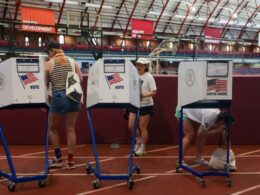In the upcoming mayoral election at the top of the list of concerns is making the city more affordable and safe. But connected to both, affordability and safety, and in fact all issues, are the quality of the city’s public schools.
An effective public school system is critical to making the city safe, affordable and economically and socially sound. Students who complete college are likely to earn more than $1 million more in the workforce and their tax revenue supports a thriving economy.
The leading candidate, Zohran Mamdani, has publicly announced his commitment to the elimination of mayoral control of the schools, and yet I can say from direct and personal experience, that this is not in the city’s best interest.
I served as deputy schools chancellor during the four-year tenure of Chancellor Joseph Fernandez in the 1990s and experienced first hand the serious problems of effective management of our city’s schools in the system before mayoral control was initiated, with state action, under former Mayor Mike Bloomberg.
Pre-mayoral control, the city schools were governed by a Board of Education consisting of seven members appointed by six different elected officials. The Board of Education was often referred to as the “Gang of Seven,” and for good reason. The mayor had only two of the seven appointees on the board.
In addition, there were 32 locally elected school districts that largely controlled all elementary schools in their geographies. School board elections often had less than 5% of local voters participating with more than 95% not participating at all, permitting control of the districts’ hiring and budgets managed by narrow special and political interests.
Corruption at the community school board level was far too common, with funds misused and hiring practices delivering incompetence. At the chancellor’s level this led to difficulties in administering effective school services.
When funds were allocated at the city or state level to fix school roofs or mitigate asbestos in schools a negotiation had to take place with board members appointed by borough presidents and locally elected school board members, leading to funds allocated not on the basis of need, but on geography and political favors. Appointments of district superintendents and principals were also far too often politically motivated, with the mayor and school chancellor’s power diluted.
This is not to say it wasn’t possible to implement needed reforms. Under Fernandez, the small schools movement began with many innovative smaller education programs replacing poorly functioning schools, and with the chancellor’s leadership, school principals’ tenure — not only to their position, but to a specific building — was eliminated, along with eliminating the dysfunctional Board of Examiners, which incorporated race into hiring.
But moving forward on needed reforms all involved negotiation, not just with legislators, but with the city’s own Board of Education, where meetings often lasted far past midnight, with a price to be paid for concession and progress.
If Mamdani’s goal of eliminating mayoral control is to give parents and communities a more important role in the city’s schools, this can and should be done, but not by returning to a totally dysfunctional pre-mayoral control system of school governance.
The mayor and the chancellor can, and should, make parent engagement a top priority, presenting programming ideas, listening to suggestions and incorporating them into implementation plans. This is not, and should not be, outside the purview of mayoral control; it is an integral part of it.
The mayor should have a leadership role in selecting a schools chancellor and framing school operations, from labor to budget and policy. Schools need to work effectively with a host of city agencies all controlled by the mayor, from police and sanitation services to child welfare, social services and yes, economic development. Mayoral control makes that coordination easier.
And the mayor needs to have a vision for improving school functioning and assist the chancellor in implementing that vision. What would that vision look like? Here are some achievable opportunities:
Many school districts across the U.S., including NYC, have focused on reading and advancing the science of reading, with good reason, but many fewer have focused similar attention on the importance of effectively teaching math. Math success connects directly to student achievement.
This is a problem, but also an opportunity, for the next mayor. There are organizations that have pioneered the effective teaching of math, especially in elementary and middle schools. Supporting teachers to increase their skill level in the teaching of math will yield higher school performance, completion rates and teacher satisfaction. Partnering with higher education partners can accomplish this, and upgrade the skill and ability of both teachers and students. This is not a budget buster, either.
Also, there has been a national movement to improve pathways from school to college, and career. During President Barack Obama’s tenure, he highlighted in his State of the Union address a school called PTECH, begun on Albany Ave. in Brooklyn. The model school combines high school and college via concurrent enrollment with a clear path to both degrees and high wage careers in technology, health care and green jobs.
PTECH has increased college completion and the successful model has spread to 15 states and 28 countries globally with more than 500 schools following the model begun with one school in Brooklyn. But in New York City, more than a dozen years later, there are only about 12 PTECH schools despite Obama saying that PTECH should be offered to all students across the U.S. and an independent evaluation conducted by the nationally-recognized MDRC, documented clearly its success. This too, is not a budget buster.
This is another opportunity for the next mayor to fulfill Obama’s mission by offering the PTECH program across the city.
The next mayor can also make expansion of after-school programs a priority, and not just focusing on things like arts and sports, but making sure instructional support is part of after-school programs. Civic instruction has also been given short shrift and far too few students have community service opportunities and internships, both are connected to school persistence and performance and need to be a top priority.
The teacher recruitment and retention crisis can be addressed with needed higher salaries and support, but also via a concerted effort to recruit into teaching a range of professionals from non-traditional areas, like those seeking a second career as a teacher as they move out of information technology.
The next mayor, chancellor and school leadership can incorporate all these into a vision for an improved public school system, with relatively low cost and longer term savings.
High quality public education will make all students more qualified for employment and career opportunities. It will benefit employers, who increasingly are struggling to find skilled talent and address the issue of affordability. Students performing at higher levels will also help make the city safer and more affordable by spending a lot less on juvenile justice and social services. And more student completers will lead to higher voting rates and stronger civic engagement.
Mayoral control is a critical component to enabling school improvement. It is not the whole of a school reform agenda, but it is integral to achieving success. But we can’t return to a system that was very dysfunctional.
Litow, a professor at Columbia University’s School of International and Public Affairs, is a SUNY Trustee and former president of the IBM Foundation and former NYC deputy schools chancellor.








